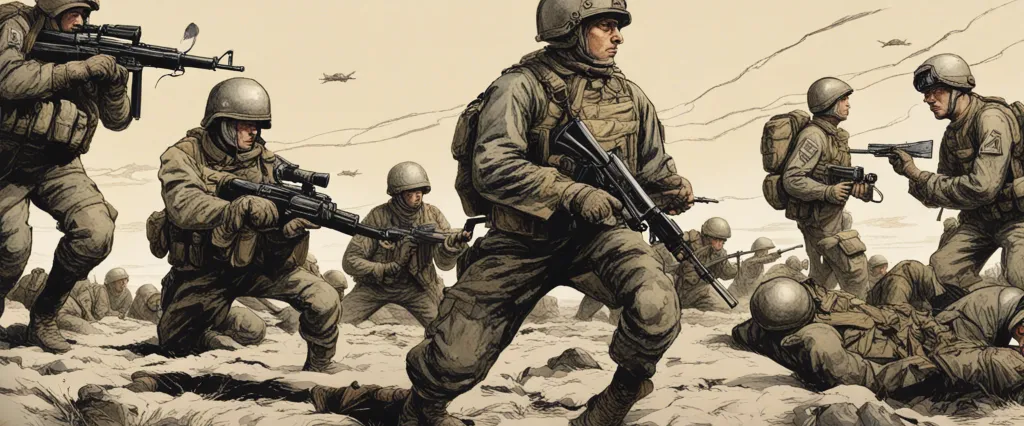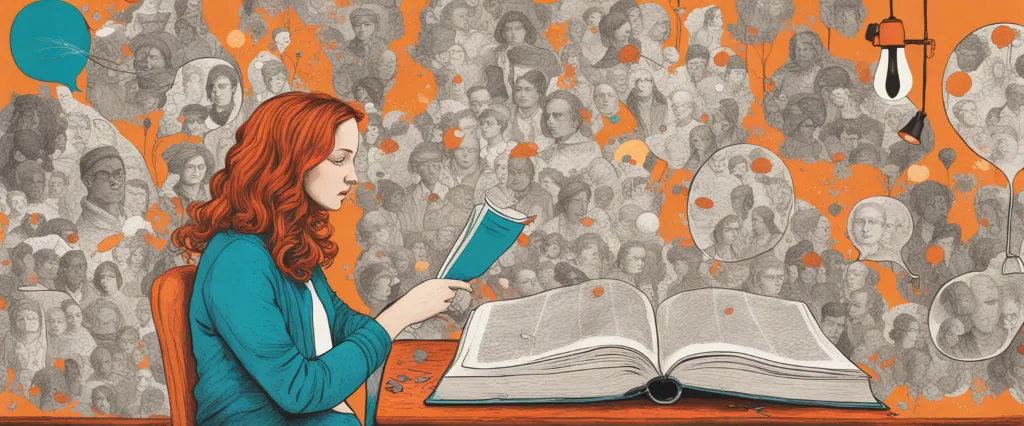In “Grunt,” Mary Roach takes readers on a fascinating and unconventional journey into the hidden world of military science. With her trademark humorous and insightful writing style, Roach explores the peculiar challenges faced by soldiers and scientists working behind the scenes to improve and preserve human lives on the battlefield. Renowned for her ability to tackle complex topics with wit and curiosity, Mary Roach has established herself as a master of engaging narrative nonfiction. Her previous works, including “Stiff,” “Bonk,” and “Gulp,” have garnered widespread acclaim, and “Grunt” continues to showcase her unique talent for delving into the strange and captivating aspects of the human experience.
Chapter 1: The Smell of War – Exploring the olfactory challenges faced by military personnel.
Chapter 1: “The Smell of War – Exploring the olfactory challenges faced by military personnel” of Mary Roach’s book “Grunt” delves into the often overlooked aspect of smell in military operations. Roach explores how smells impact soldiers’ experiences, both physically and psychologically, and the innovative solutions developed to mitigate their effects.
Roach begins by highlighting the pungent and repulsive smells of war, focusing on the stench produced by decomposing bodies. She visits an odor research lab where scientists attempt to capture the scent of human decay, aiming to enhance the training of cadaver dogs and develop chemical sensors to detect buried landmines. The chapter also delves into the challenges faced by forensic anthropologists in identifying bodies in combat zones.
Moving on, Roach explores the use of smell as a weapon during warfare. Deliberate manipulation of odor, known as “olfactory warfare,” involves using stink bombs to disable enemy forces by making their environment unbearable. She describes the psychological impact of foul smells on soldiers, affecting their morale and well-being.
Roach then focuses on the unseen dangers posed by toxic gases and chemicals used in war zones. She delves into the development of protective measures, such as gas masks and chemical suits, by visiting research facilities where scientists test the effectiveness of these tools.
Additionally, Roach discusses the crucial role that smell plays in survival and adaptation. Soldiers’ awareness of environmental scents, such as smoke or burning rubber, can be the difference between life and death. Roach explores the complexity of detecting improvised explosive devices (IEDs) through scent training programs, demonstrated by specially trained dogs and scientists working on developing electronic noses.
Overall, Chapter 1 of “Grunt” emphasizes the underestimated role of smell in military operations, highlighting its physical and psychological impacts on soldiers and the efforts made to address these challenges through technological advancements and innovative training techniques.
Chapter 2: Maggot Therapy – Unconventional medical treatments for wounded soldiers.
Chapter 2 of “Grunt” by Mary Roach explores the use of maggot therapy as an unconventional medical treatment for wounded soldiers. The chapter investigates the potential benefits, limitations, and methods of implementing this unique treatment.
Maggot therapy involves the use of medical grade maggots to help clean and heal wounds that are not responding to conventional treatments. The maggots, which are applied directly to the wound, consume the dead and infected tissue while leaving the healthy tissue untouched. This process of debridement has proved effective in promoting wound healing and reducing the risk of infection.
Roach examines the historical significance of maggot therapy, which dates back to ancient times, and how it gradually disappeared from medical practice until its rediscovery in the mid-20th century. She delves into the science behind maggot therapy, highlighting the specific species of maggots used and the optimal conditions required for their usage.
The chapter also explores the hesitations and misconceptions surrounding the treatment. Many soldiers and medical personnel initially find the idea repulsive, but Roach emphasizes the benefits and the success stories of soldiers who have healed significantly due to maggot therapy. However, logistical challenges exist, such as the need for a reliable supply of medical grade maggots and the time and resources required for proper treatment.
Furthermore, Roach emphasizes the crucial role of conducting scientific studies and gathering empirical evidence to validate the effectiveness of maggot therapy. Scientists have conducted experiments to assess the appropriate dosage of maggots, develop innovative containment methods, and analyze the impact of maggot therapy on different wound types.
In summary, Chapter 2 of “Grunt” delves into the fascinating and unconventional world of maggot therapy for wounded soldiers, exploring its historical significance, scientific basis, and the potential it holds as a highly effective and beneficial medical treatment.
Chapter 3: Uniforms and Gear – Examining the science behind military clothing and equipment.
Chapter 3 of “Grunt” by Mary Roach, titled “Uniforms and Gear – Examining the science behind military clothing and equipment,” delves into the fascinating world of military apparel and equipment. In this chapter, Roach explores the various innovative technologies and scientific advancements behind military gear, aiming to uncover the ways in which these advancements safeguard the lives of soldiers.
Roach begins by highlighting the role of uniforms, investigating their composition and features. She dives into the complexity of form-fitting combat clothing, which ranges from heat-resistant and invisible to infrared light fabrics to odor-reducing undergarments. Roach examines how these advancements contribute to the comfort, safety, and functionality of soldiers in the battlefield.
The chapter then delves into the vital aspect of body armor, examining the different materials, their efficacy, and limitations. Roach explores the never-ending race between military research and the relentless agility of firearms. She engages with experts and scientists who tirelessly improve the protection offered by body armor, discussing the challenges faced, including weight, flexibility, and durability.
Furthermore, the author scrutinizes the cutting-edge technology employed in specialized equipment designed for various divisions in the military, such as night-vision goggles, hearing protection, and even military-grade undies. Roach uncovers the rigorous testing methods employed to ensure these gears meet the demands of soldiers while exposed to extreme conditions.
Overall, Chapter 3 of “Grunt” exposes readers to the scientific endeavors that underlie the design and development of military clothing and equipment. By exploring the intricate world of uniforms, body armor, and specialized gear, Roach sheds light on the relentless pursuit of providing soldiers with the best possible protection and enhancing their capabilities on the battlefield.
Chapter 4: Combat Medicine – Innovations in battlefield medical care.

Chapter 4 of Mary Roach’s book “Grunt: The Curious Science of Humans at War” focuses on combat medicine and the innovative techniques developed to provide effective care for wounded soldiers on the battlefield.
Roach introduces the chapter with the story of a soldier who suffered a gunshot wound to the neck, which severed his carotid and jugular veins. Despite seemingly unsurvivable injuries, he managed to survive and recover due to the extraordinary efforts of combat medics. Roach explores the advancements in technology, training, and medical procedures that have contributed to improved combat medicine.
She delves into the development of tourniquets, highlighting their effectiveness in stopping traumatic bleeding when applied properly. Roach then moves on to the role of blood and blood products in treating injured soldiers. She discusses the challenges faced in maintaining supplies of blood in remote locations and the introduction of freeze-dried plasma as a viable solution.
Roach also highlights the importance of quick and accurate diagnosis on the battlefield. She explores the advancements in portable imaging technology, such as ultrasound units, which allow medics to quickly assess injuries and provide appropriate treatment. Additionally, she discusses innovations in prosthetics and rehabilitation, focusing on efforts to improve outcomes for amputees.
Throughout the chapter, Roach shares anecdotes and interviews with medical professionals and researchers who are committed to improving the care provided to soldiers. She emphasizes the crucial role of combat medicine in saving lives and offers insights into the challenges and ongoing efforts to push boundaries and find new solutions to battlefield medical care.
In conclusion, Chapter 4 of “Grunt” provides a comprehensive overview of the innovations and advancements in combat medicine that have improved the chances of survival and recovery for wounded soldiers on the battlefield.
Chapter 5: Digestive Difficulties – Dealing with gastrointestinal issues in extreme environments.
Chapter 5 of “Grunt” by Mary Roach explores the unique challenges faced by military personnel while dealing with digestive difficulties in extreme environments. Roach investigates the gastrointestinal problems soldiers encounter, particularly focusing on the military’s efforts to minimize digestive issues during combat and training.
The chapter delves into the various factors that contribute to these digestive difficulties, such as stress, dietary changes, infections, and exposure to unfamiliar and unhygienic environments. Roach highlights the importance of proper nutrition and digestion for soldiers to maintain their physical capabilities and overall well-being in combat.
Roach also explores military research facilities where scientists study ways to enhance soldiers’ digestion and absorption of nutrients, enabling them to function optimally in extreme conditions. These research efforts include examining specific enzymes that aid digestion, developing specialized food rations tailored to individual soldiers, and designing combat gear that minimizes gastrointestinal issues caused by pressure changes at high altitudes.
Additionally, the chapter delves into the use of probiotics and fecal transplants to restore soldiers’ gut health. Roach explains how these interventions, which involve introducing beneficial bacteria into the gut, have the potential to alleviate digestive discomfort and improve soldiers’ overall resilience.
Throughout the chapter, Roach incorporates various interviews with military personnel, physicians, and scientists to shed light on the challenges faced by troops and the innovative solutions being developed to mitigate digestive difficulties in extreme environments.
In summary, Chapter 5 of “Grunt” explores the intricacies of digestive difficulties faced by military personnel in extreme environments. Through scientific research and advancements, the military strives to address these challenges by optimizing soldiers’ nutritional intake, enhancing digestion, and maintaining gut health.
Chapter 6: Hearing Loss – Understanding the impact of loud noises on soldiers’ hearing.
Chapter 6 of “Grunt” by Mary Roach titled “Hearing Loss – Understanding the Impact of Loud Noises on Soldiers’ Hearing” explores the major issue of hearing loss faced by soldiers during combat situations and analyzes different ways to prevent or mitigate such losses.
The chapter begins by highlighting the prevalence of hearing damage in combat zones and its long-term consequences for soldiers. Roach covers the basics of how hearing works, including the delicate mechanisms of the ear and the damaging effects of loud noises on the ear’s inner structures. She then delves into the experiences of soldiers who have suffered hearing loss, emphasizing the impact it has on communication, situational awareness, and mental well-being.
To address this serious issue, Roach explores several ongoing research efforts aimed at improving hearing protection for soldiers. She discusses the development of advanced earplugs that can block out harmful noises while still allowing soldiers to hear important sounds, such as commands or approaching vehicles. Additionally, she examines the use of transcranial magnetic stimulation as a potential treatment for hearing loss, which involves the use of magnetic fields to stimulate nerves in the brain and potentially restore some hearing function.
Throughout the chapter, Roach incorporates interviews with experts in audiology and military personnel to provide an in-depth understanding of the complexity and challenges faced in combat-related hearing loss. While progress is being made in improving hearing protection and rehabilitating damaged hearing, the chapter also acknowledges the limitations and ongoing research required to effectively combat this issue.
In summary, Chapter 6 of “Grunt” sheds light on the far-reaching consequences of hearing loss faced by soldiers, explores current advancements in hearing protection, and underscores the need for further research and innovation to preserve soldiers’ hearing abilities on the battlefield.
Chapter 7: Stress and Fatigue – Exploring the psychological and physical toll of combat.
Chapter 7 of “Grunt” by Mary Roach explores the psychological and physical toll of combat, specifically focusing on stress and fatigue experienced by soldiers. The chapter delves into the various aspects of combat that contribute to these issues and discusses the research and innovations aimed at mitigating these challenges.
Roach begins by describing the intense stress experienced by soldiers in combat, highlighting how the constant threat to their lives and witnessing the deaths of comrades can lead to psychological trauma. She sheds light on the importance of mental preparation and training to manage ongoing stress, sharing examples of programs developed by militaries to help soldiers cope with the psychological burden.
The chapter then delves into the topic of fatigue, emphasizing how the lack of quality sleep drastically affects soldiers’ ability to perform and make critical decisions during combat. Roach explores different strategies and innovations aimed at improving sleep conditions in the military, such as designing more comfortable and ergonomic gear and experimenting with sleep-inducing medications.
Additionally, Roach addresses the issue of cognitive overload, which arises when soldiers are required to process vast amounts of information simultaneously. She discusses the challenge of multitasking in combat situations and the importance of training soldiers to manage these demanding scenarios effectively.
Throughout the chapter, Roach provides a balanced view of the psychological and physical challenges soldiers face in combat. She presents both the advancements and limitations in research and technology, highlighting the humanitarian efforts focused on improving the well-being of military personnel. Ultimately, the chapter sheds light on the intricate relationship between stress, fatigue, and combat, showcasing the ongoing efforts to protect and support those serving on the front lines.

Chapter 8: Beyond the Battlefield – Investigating the long-term effects of military service on veterans.
Chapter 8 of “Grunt” by Mary Roach, titled “Beyond the Battlefield – Investigating the long-term effects of military service on veterans,” delves into the various physical and psychological challenges that military veterans face after their service. Roach explores the efforts of scientists and researchers to understand and address these issues.
Roach begins by discussing the debilitating pain that some veterans experience due to their injuries. She highlights the innovative work of bioengineers who are developing prosthetic limbs and cutting-edge pain management techniques to improve the quality of life for these individuals. Roach also explores the frustrating limitations of current technology and the ongoing challenges of adapting to and managing pain.
Moving onto mental health, Roach explores the mental trauma that many veterans endure, particularly post-traumatic stress disorder (PTSD). She investigates different techniques used to help veterans cope with the psychological impact of their experiences, including virtual reality exposure therapy and the use of service dogs to provide emotional support.
Additionally, Roach explores the mysterious cases of Gulf War Syndrome and the advances made in understanding the complex mix of symptoms experienced by veterans of that conflict. She also examines the adverse effects of military noise and the efforts to develop better hearing protection for soldiers.
In “Beyond the Battlefield,” Roach highlights the dedication of scientists, engineers, and medical professionals working to understand and alleviate the long-term consequences of military service. Through their innovative research and technological advancements, they strive to enhance the physical and mental well-being of veterans, ensuring they receive the support they need and deserve.
After Reading
In conclusion, Mary Roach’s book “Grunt” takes readers on an intriguing and entertaining journey into the world of military science. Through extensive research and engaging storytelling, Roach sheds light on the often overlooked but vital aspects of war and military life. She explores the innovative and occasionally bizarre efforts to prevent and mitigate the challenges faced by soldiers, from combating heat and noise to dealing with diarrhea and sleep deprivation. Roach successfully blends humor with serious scientific inquiry to present a comprehensive and thought-provoking examination of the less glamorous side of military operations. “Grunt” ultimately serves as a reminder of the immense dedication and ingenuity required to ensure the well-being and effectiveness of those who serve in the armed forces.
1. “Stiff: The Curious Lives of Human Cadavers” by Mary Roach – If you enjoyed “Grunt” by Mary Roach, you would definitely love her book “Stiff.” It explores the fascinating world of human cadavers, from medical research to body farms and the history of embalming.
2. “The Violinist’s Thumb: And Other Lost Tales of Love, War, and Genius, as Written by Our Genetic Code” by Sam Kean – This captivating book delves into the mysteries of our DNA and how it shapes our lives. From the history of eugenics to the origins of human love and war, Sam Kean weaves a compelling narrative filled with fascinating stories.
3. “The Butchering Art: Joseph Lister’s Quest to Transform the Grisly World of Victorian Medicine” by Lindsey Fitzharris – For those interested in the medical history aspect of “Grunt,” this gripping account of Joseph Lister’s pioneering efforts to establish antiseptic surgery in Victorian times is a must-read. It explores the gruesome and transformative world of surgery during that era.
4. “Packing for Mars: The Curious Science of Life in the Void” by Mary Roach – Another fascinating book by Mary Roach, “Packing for Mars” uncovers the peculiar scientific challenges behind human space exploration. Roach humorously explores topics such as astronaut hygiene, astronaut selection, and the strange effects of zero gravity on the human body.
5. Gulp: Adventures on the Alimentary Canal” by Mary Roach – Mary Roach’s signature blend of science, humor, and curiosity shines in “Gulp,” as she takes readers on an entertaining and informative journey through the digestive system. From the peculiar stories of taste testers to the mysteries behind flatulence, this book uncovers the wonders hidden within our bodies.




